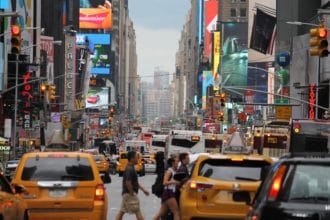 Zef Hemel is a man with a plan.
Zef Hemel is a man with a plan.
A former urban planner for the city of Amsterdam and my colleague at the Amsterdam Economic Board, he has been a vocal proponent of dramatically increasing the population of this city. He envisions a future where Amsterdam is home to 2 million people, more than double the population that currently lives here now.
Unsurprisingly, Hemel’s proposal has made him a bit of a controversial figure around town. Amsterdammers are fiercely protective of their city, and many fear that an influx at the scale that Hemel proposes would diminish the quality of life that they currently enjoy.
Are their fears legitimate? Amsterdam offers a truly unique way of life, and it makes sense that a massive population increase would be perceived as a threat. But greater population density and a high quality of life are not mutually exclusive things. It all comes back to planning and design.
Paris, generally seen as one of the most beautiful and liveable cities in the world, has almost twice the population density of New York City. It packs in over 54,000 people per square mile to New York’s 28,000. Barcelona, another one of the world’s great cities, is also nearly 50 percent more densely populated than New York. For comparison, Amsterdam is currently home to 12,710 people per square mile, a bit less than Boston and a bit more than Philadelphia. Twice as many residents would put Amsterdam’s population density in the company of Bilbao, Bucharest, and Lyon—hardly a group of overcrowded urban dystopias.
Since hearing of Hemel’s plans, I’ve kept an eye out for where this city might create greater density. The most obvious target is the southern bank of Amsterdam-Noord, just across the river IJ. This area will soon be made tremendously more accessible by a pedestrian and cyclist bridge. As of now, you need to take a ferry to cross the water.
Many neighborhoods outside the city center also have significant amounts of underutilized space. The area near me in the Oost, for example, seems to present some solid, relatively straightforward opportunities. Just around the corner from me (near the INIT building, for you locals) is a large parking lot, a significant amount of vacant land, and a big, underutilized former warehouse. A few blocks further in Kattenburg, there is an even larger stretch of underutilized space owned by the Dutch Navy.
Of course, achieving greater population density would mostly come from building slightly higher residential buildings in various neighborhoods around the city. Newer parts of the city (where the iconic row houses give way to late nineteenth or early twentieth century apartment blocks) would likely be the target here. Neighborhood redevelopment is always logistically complex and politically contentious, but it seems reasonable to assume that creating more units in these “garden city” neighborhoods could contribute significantly to housing supply and leave residents’ quality of life intact.
 Taking a step back, why should Amsterdam grow? What would be the point of accommodating twice as many people? For that matter, why should any city seek to increase its population?
Taking a step back, why should Amsterdam grow? What would be the point of accommodating twice as many people? For that matter, why should any city seek to increase its population?
From an economic standpoint, accommodating more skilled workers helps boost local economic productivity and growth. In a global economy where cities compete with each other for skilled workers, housing availability and affordability is a critical distinguishing factor—inherent to Hemel’s vision is the notion that Amsterdam would be able to attract significantly more talented workers with cheaper housing. And given the size of the Netherlands, maintaining Amsterdam’s globally-competitive edge isn’t just a local imperative—the Dutch national economy will largely rise and fall with Amsterdam’s fate.
From a cultural standpoint, Amsterdam has long defined itself as a place that welcomes young, creative, freethinking individuals. This atmosphere is a huge part of the city’s overall attractiveness. But with demand for housing so dramatically exceeding supply, many of these kinds of people can no longer afford to live here. If more housing is not built, the city risks losing this core advantage and source of identity, instead becoming a less dynamic place that caters increasingly to the wealthy.
In my mind, it seems clear that Amsterdam would do well to increase its housing supply. The question is: by how much? Thanks to Zef Hemel, the conversation is well underway.
Ross Tilchin is a visiting fellow at the Amsterdam Institute for Social Science Research and a member of the strategy team at the Amsterdam Economic Board. Before arriving in Amsterdam, Ross worked as a researcher at the Brookings Institution, a nonprofit research organization in Washington, D.C., where he specialized in urban economic development and a wide range of issues related to cities. You can read his previous blog here.
